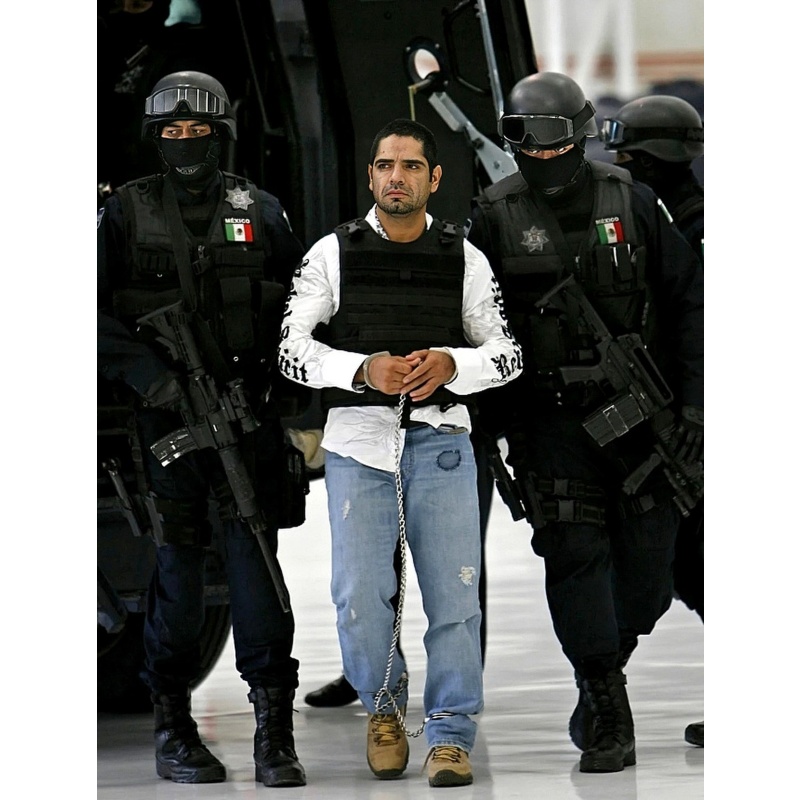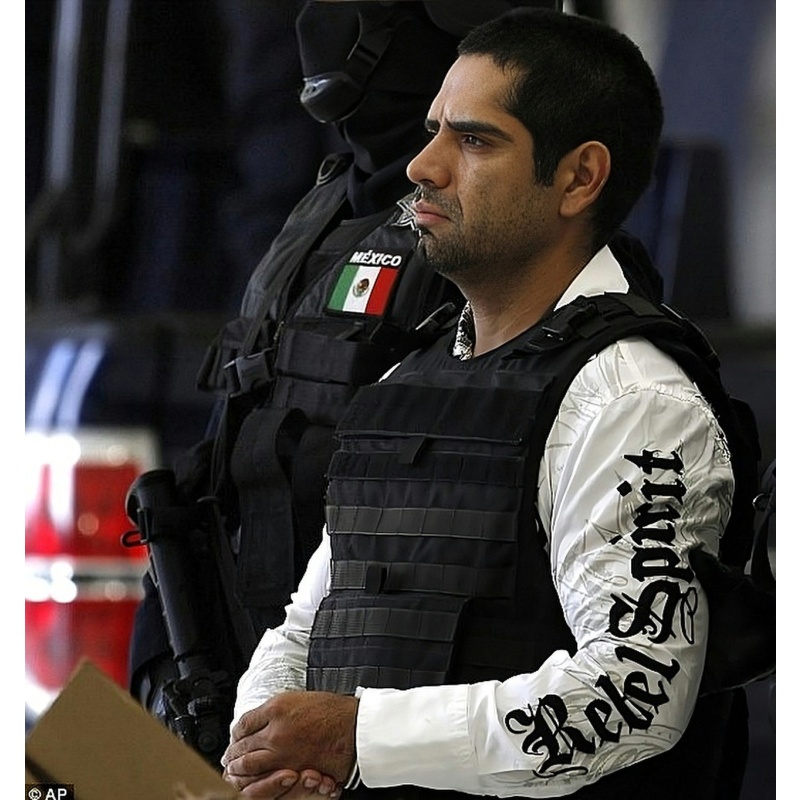JOSÉ ANTONIO ACOSTA-HERNÁNDEZ | The Butcher of Juárez: “El Diego” | Drug Cartel Enforcer Admits to More Than 1,500 Murders | Serving Three Consecutive Life Sentences Plus 20 Years | Autographed Letter Signed
LongfellowSerenade 67
José Antonio Acosta-Hernandez, also known as "El Diego," was a high-ranking leader of the Juarez Cartel's enforcement arm, La Linea, and the "plaza boss" in Juarez and Chihuahua, Mexico. He was sentenced to life in federal prison after pleading guilty to racketeering, narcotics trafficking, money laundering, and multiple counts of murder and weapons charges. Acosta-Hernandez admitted to directing or participating in over 1,500 murders since 2008, including the murders of U.S. consulate employees. He was associated with the Barrio Azteca, a violent street and prison gang that allied with La Linea to fight rival cartels. There are other individuals named José Antonio Acosta, but they are unrelated to the criminal activities of José Antonio Acosta-Hernandez.
"For example, Acosta-Hernandez admitted that on Jan. 30, 2010, he ordered hit-men in his organization to kill members of the opposition that were sighted at a daytime birthday party at a home in Juarez," prosecutors said in the statement. "As part of this incident, 16 individuals were killed and 10 individuals were wounded at three different residences in Juarez. On July 15, 2010, Acosta-Hernandez directed a car bombing in Juarez that ultimately killed four people."
$100.00
- Closed
- Postage
-
Standard Shipping
$0.00 to United States
Get Additional Rates
- Select Country
- Zip/Post Code
- Quantity
Description
José Antonio Acosta. Autographed Letter, Signed. Handwritten, Commercial #10 (4.125 × 9.5 envelope). Saint Petersburg, FL. May 21, 2025. Content unknown. SEALED.
In the scorched borderlands between Mexico and the United States, a single man orchestrated a reign of terror that echoed through cartel corridors, political offices, and courtroom chambers. José Antonio Acosta, a former cop turned mass murderer, became infamous not just for the sheer volume of lives he extinguished—he confessed to killing over 1,500 people—but for the cold military precision with which he carried out his crimes. His story is one of betrayal: of a badge once worn with pride, of humanity once held sacred, and of a city—Ciudad Juárez—thrust into chaos and fear. As a commander in the criminal arm of the Juárez Cartel known as La Línea, Acosta was more than just a killer. He was a tactician, an executioner, a ghost in a war zone that few outside Mexico understood. This is his brutal, blood-soaked legacy.
The Butcher of Juárez: The Story of José Antonio Acosta Hernández
José Antonio Acosta Hernández was born in 1978 in the Mexican state of Chihuahua, likely in or near Ciudad Juárez, the epicenter of the carnage he would one day unleash. His full name, while mundane to the uninitiated, would become synonymous with bloodshed across the borderlands. Known in the underworld by his alias “El Diego,” Acosta rose to infamy as one of the most feared enforcers of the Juárez Cartel, and the architect behind one of the most prolific killing sprees in the drug war’s grim history. As of this writing, he remains incarcerated in Mexico, having been convicted for crimes that span nearly a decade of relentless violence.
In his youth, Acosta appeared to walk the straight and narrow path. He entered law enforcement and served as a police officer in Ciudad Juárez. But corruption is a contagion in the high-stakes world of borderland policing, and Acosta was not immune. He crossed over—figuratively and permanently—into the service of La Línea, the armed wing of the Juárez Cartel. There, he quickly shed the skin of a public servant and adopted the mantle of a paramilitary operative. He was no longer José, the officer of the peace. He became El Diego, commander of death squads, master of targeted terror, and a man who could erase entire families without a flicker of remorse.
His descent into darkness found fertile soil in Ciudad Juárez during the late 2000s, a period when the Sinaloa Cartel—led by Joaquín “El Chapo” Guzmán—was aggressively trying to wrest control of drug trafficking routes from the Juárez Cartel. The city, already plagued by poverty and corruption, became a war zone. Acosta's role in this conflict was not merely that of a foot soldier. He operated with the strategic mind of a battlefield general. Under his command, La Línea executed coordinated attacks, ambushes, car bombings, and mass executions. His unit operated with military discipline and near-total impunity. Acosta became infamous for his ability to direct complex assassinations and disappearances, striking fear not only into rival gang members but into police, journalists, politicians, and civilians alike.
Among the crimes that marked his ascension to infamy, none was more publicly reviled than the March 13, 2010 ambush in Juárez that left three people affiliated with the U.S. consulate dead. A consular employee, her husband, and another man were gunned down in a targeted shooting as they left a child’s birthday party. The murders triggered an international uproar, drawing the full attention of the U.S. government. For years, Acosta had operated in the shadows, but now the spotlight blazed white-hot.
Law enforcement in both Mexico and the United States began a concerted hunt. Mexican authorities offered a multi-million peso reward, while U.S. officials placed him high on their most-wanted list. Eventually, the net closed. In July 2011, Acosta was captured in Chihuahua City by Mexican federal police. The arrest, while celebrated, revealed just a fraction of his chilling capabilities. In custody, Acosta coolly confessed to ordering or personally carrying out more than 1,500 murders. Among the deaths were decapitations, mass graves, executions of police officers, and the torture-killing of rival cartel operatives. His interrogators noted how calm, how disturbingly indifferent he remained, even as he recalled atrocities that would break most men’s minds.
Following his capture, legal proceedings moved swiftly. Acosta faced charges in both Mexico and the United States. In January 2012, he was extradited to El Paso, Texas, where he faced federal charges for the murder of the consular staff. He pleaded guilty to those killings, as well as a host of other federal crimes, including racketeering and conspiracy to distribute narcotics. In April 2012, he was sentenced to 10 concurrent life terms without the possibility of parole. His sentencing closed a chapter, but not the book, on his grim legacy.
The victims of Acosta's campaign number in the thousands. Many remain nameless—buried in clandestine graves, thrown into desert pits, or reduced to bones in unmarked territory. Some were rival gang members, but many were innocents: women, children, political targets, and bystanders caught in the crossfire. The psychological impact on Ciudad Juárez was incalculable. During Acosta’s reign, the city bore the unenviable title of the murder capital of the world. Families fled. Schools closed. Businesses shuttered under the weight of extortion and fear. Paranoia was the atmosphere. Nightfall became a sentence.
The media painted Acosta as a modern-day boogeyman, while human rights groups decried the systemic failures that allowed his operation to flourish. His arrest brought temporary relief, but the scars on Juárez run deep. The city still struggles with corruption and cartel influence, though it has seen a reduction in killings since Acosta’s removal from the battlefield. Legal scholars and journalists pointed to his case as a stark indictment of Mexico’s compromised justice system and the American insatiability for narcotics, which together create the breeding ground for men like El Diego.
Today, José Antonio Acosta remains imprisoned in the United States, cut off from his network, his city, and the deadly dominion he once ruled. There is no indication of remorse. No statement of contrition. No public-facing effort at rehabilitation. In truth, few believe rehabilitation is possible for a man who systematically orchestrated the deaths of over a thousand human beings. Should he ever escape or be released—an almost unimaginable possibility—he would pose a profound threat to public safety.
What can be learned from this tale soaked in blood and dust? First, that systems collapse when corruption becomes endemic. Second, that cartels do not simply trade in drugs, but in fear, loyalty, and death. And finally, that individuals like Acosta are not born as monsters—they are made by a toxic fusion of desperation, power, and impunity. The world watched as a former cop became a commander of corpses, a man who sent thousands to their graves with orders muttered from behind tinted windows.
For collectors of true crime and criminal memorabilia, an authentic autographed item from José Antonio Acosta would be exceptionally rare and potentially valuable. Given the international attention on his case and the severity of his crimes, any such item would carry not just monetary worth but historical weight, representing a notorious chapter in the bloody ledger of Mexico’s drug war.
This is the story of José Antonio Acosta—El Diego—the man who made a city bleed, and whose shadow lingers still.
VIDEO: Mexican gang suspect 'admits 1,500 murders' | https://youtu.be/xTUUUDF_r7I
VIDEO: Interpol vs The Juárez Cartel: Inside The Infamous Drug War | https://youtu.be/wsWv9T8-W8g
Archiving Protocol:
• Handled with White Gloves ab initio
• Photo Pages/Sheet Protectors: Heavyweight Clear Sheet Protectors, Acid Free & Archival Safe, 8.5 × 11, Top Load
• White Backing Board—Acid Free
Shipping/Packaging: Rigid Mailer 9.5 × 12.5. The Kraft cardboard is white, self-seal, and stay-flat, ensuring it does not bend. Heavy cardboard, which has strong resistance to bending and tearing, makes each rigid mailer sturdy. These mailers are significantly thicker than those used by the USPS. Shipping cost is never more than it absolutely has to be to get it from me to you.
Payments & Returns
- Payment Methods
- PayPal, Money Order
Postage & Shipping
- Item Location
- 49858, Michigan, United States
- Ships To
- Worldwide
- Pick-ups
- No pick-ups
- Shipping Instructions
- Shipping costs to international destinations will be applied to this auction. Please contact us if you have any questions about shipping to your location.
- Returns Accepted
- No

-800x800.jpg)
-800x800.jpg)
-800x800.jpg)






-500x500.jpg)